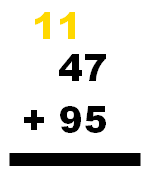What is the Function of Working Memory?
Posted by PLB · Leave a Comment

 Working memory is the ability to retain information for short periods of time while processing or using it. This can be as subtle as when adding numbers that involve “holding” numbers in mind (the numbers 1 and 1 in the example shown).
Working memory is the ability to retain information for short periods of time while processing or using it. This can be as subtle as when adding numbers that involve “holding” numbers in mind (the numbers 1 and 1 in the example shown).
Some signs to watch out for is a student’s inability to:
- remember even simple, short instructions from one step to the next, and
- calculate multi-digit math problems in their head.
A student’s learning suffers if information cannot be retained long enough to handle it properly.
One function of working memory is to keep track of input. This system evaluates incoming information and keeps attention moving forward. Information is held and evaluated, and a decision is made to discard the information or save it for use at some future time. For example: when adding 77, 89, and 65. After totaling the first column and getting a sum of 21, we need to keep the 2 in our mind to add to the total of the second column.
Working memory allows us to work faster by retaining certain information that we’ll soon need to reuse instead of taking additional time to write it down or redo a task because we forget something.
Forgetting the right things can be good. One of the major functions of working memory is to prevent useless information from encoding to long-term memory.
Learn More… Take this course: Cognitive Skills – Understanding Learning Challenges
Discuss Here: What is another function of working memory that is important for the students’ learning?



